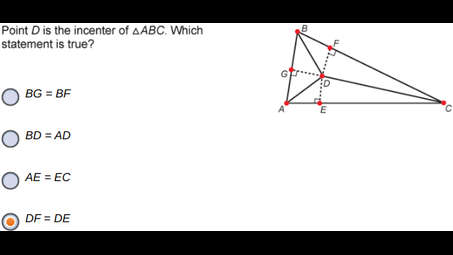What else can I help you with?
What is the length of the tangent from the external point D to point B?
To find the length of the tangent from an external point D to point B on a circle, you can use the formula ( \text{Length} = \sqrt{d^2 - r^2} ), where ( d ) is the distance from point D to the center of the circle, and ( r ) is the radius of the circle. If you have the specific values of ( d ) and ( r ), you can substitute them into the formula to calculate the length of the tangent.
Where is the exponential growth happening in the graph shown above?
point a.
What formula can he use to determine the distance from point C to point D?
To determine the distance from point C to point D, he can use the distance formula: ( d = \sqrt{(x_2 - x_1)^2 + (y_2 - y_1)^2} ), where ( (x_1, y_1) ) are the coordinates of point C and ( (x_2, y_2) ) are the coordinates of point D. By plugging in the respective coordinates into this formula, he can calculate the straight-line distance between the two points.
Look at the metric ruler pictured assuming that 0 is visible on the ride and is also on the starting point what is the distance to point d?
To determine the distance to point D using the metric ruler, measure the length from the starting point (0 cm) to point D on the ruler. The value indicated at point D will give you the distance in centimeters. Ensure you read the measurement accurately, considering any potential parallax error when viewing the ruler.
How many miles does it take to travel from point D to E At 640miles?
To travel from point D to E, it takes 640 miles. This distance is fixed and does not change regardless of the route or method of travel. Thus, you would need to cover the entire 640 miles to reach point E from point D.
How do the ages of the rock change from point B to point D?
From point E to point D also??
What decimal identifies point D?
The answer depends on where or what point D is.
What point in this body of water is most likely to be in the aphotic zone?
Point D -Apex :)
What happens to the temperature and density at point D and A?
As point D turns right to Point A the temperature increases and the density decreases
How much higher is yhe land at point D than at point F How do you know?
To determine how much higher the land at point D is compared to point F, you would need to know the elevation measurements of both points. If, for example, point D has an elevation of 300 meters and point F has an elevation of 250 meters, then the land at point D is 50 meters higher than at point F. The difference in elevation can be calculated by subtracting the elevation of point F from that of point D.
What is the length of the tangent from the external point D to point B?
To find the length of the tangent from an external point D to point B on a circle, you can use the formula ( \text{Length} = \sqrt{d^2 - r^2} ), where ( d ) is the distance from point D to the center of the circle, and ( r ) is the radius of the circle. If you have the specific values of ( d ) and ( r ), you can substitute them into the formula to calculate the length of the tangent.
Which point does does not mark an international border?
point d
What is the southernmost point of the Indian Union?
The Indira Point =D
What is the location of a point on a coordinate?
Each point in 1-dimensional or 2-d or 3-d or n-d space has a set of 1, 2, 3 or n coordinates and these, TOGETHER, identify the location of the point.
Where is the exponential growth happening in the graph shown above?
point a.
How many miles does it takes to travel point A to point B which is 320 then from point B to point C which is 550 then from point C to point D which is 640?
Traveling at 60 miles per hour how long would it take to travel from point C to point D?
Look at the metric ruler pictured. Assuming that 0 is visible on the measure and is also the starting point what is the distance to point D?
The distance to point D is 2.4 cm.

